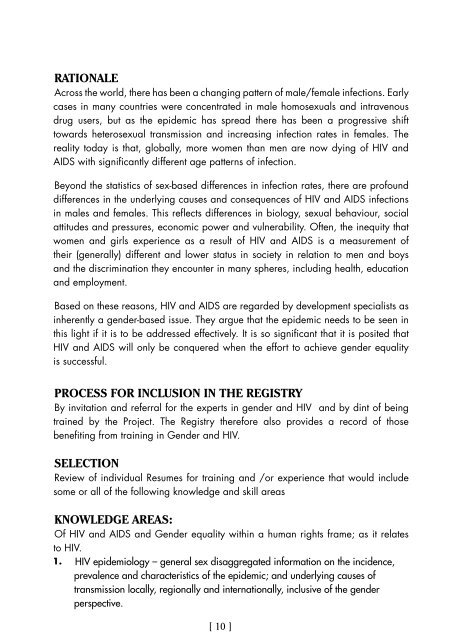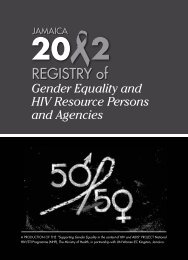Gender Equality and HIV Resource Persons and Agencies
Gender Equality and HIV Resource Persons and Agencies
Gender Equality and HIV Resource Persons and Agencies
You also want an ePaper? Increase the reach of your titles
YUMPU automatically turns print PDFs into web optimized ePapers that Google loves.
RATIONALE<br />
Across the world, there has been a changing pattern of male/female infections. Early<br />
cases in many countries were concentrated in male homosexuals <strong>and</strong> intravenous<br />
drug users, but as the epidemic has spread there has been a progressive shift<br />
towards heterosexual transmission <strong>and</strong> increasing infection rates in females. The<br />
reality today is that, globally, more women than men are now dying of <strong>HIV</strong> <strong>and</strong><br />
AIDS with significantly different age patterns of infection.<br />
Beyond the statistics of sex-based differences in infection rates, there are profound<br />
differences in the underlying causes <strong>and</strong> consequences of <strong>HIV</strong> <strong>and</strong> AIDS infections<br />
in males <strong>and</strong> females. This reflects differences in biology, sexual behaviour, social<br />
attitudes <strong>and</strong> pressures, economic power <strong>and</strong> vulnerability. Often, the inequity that<br />
women <strong>and</strong> girls experience as a result of <strong>HIV</strong> <strong>and</strong> AIDS is a measurement of<br />
their (generally) different <strong>and</strong> lower status in society in relation to men <strong>and</strong> boys<br />
<strong>and</strong> the discrimination they encounter in many spheres, including health, education<br />
<strong>and</strong> employment.<br />
Based on these reasons, <strong>HIV</strong> <strong>and</strong> AIDS are regarded by development specialists as<br />
inherently a gender-based issue. They argue that the epidemic needs to be seen in<br />
this light if it is to be addressed effectively. It is so significant that it is posited that<br />
<strong>HIV</strong> <strong>and</strong> AIDS will only be conquered when the effort to achieve gender equality<br />
is successful.<br />
PROCESS FOR INCLUSION IN THE REGISTRY<br />
By invitation <strong>and</strong> referral for the experts in gender <strong>and</strong> <strong>HIV</strong> <strong>and</strong> by dint of being<br />
trained by the Project. The Registry therefore also provides a record of those<br />
benefiting from training in <strong>Gender</strong> <strong>and</strong> <strong>HIV</strong>.<br />
SELECTION<br />
Review of individual Resumes for training <strong>and</strong> /or experience that would include<br />
some or all of the following knowledge <strong>and</strong> skill areas<br />
KNOWLEDGE AREAS:<br />
Of <strong>HIV</strong> <strong>and</strong> AIDS <strong>and</strong> <strong>Gender</strong> equality within a human rights frame; as it relates<br />
to <strong>HIV</strong>.<br />
1.<br />
<strong>HIV</strong> epidemiology – general sex disaggregated information on the incidence,<br />
prevalence <strong>and</strong> characteristics of the epidemic; <strong>and</strong> underlying causes of<br />
transmission locally, regionally <strong>and</strong> internationally, inclusive of the gender<br />
perspective.<br />
[ 10 ]



